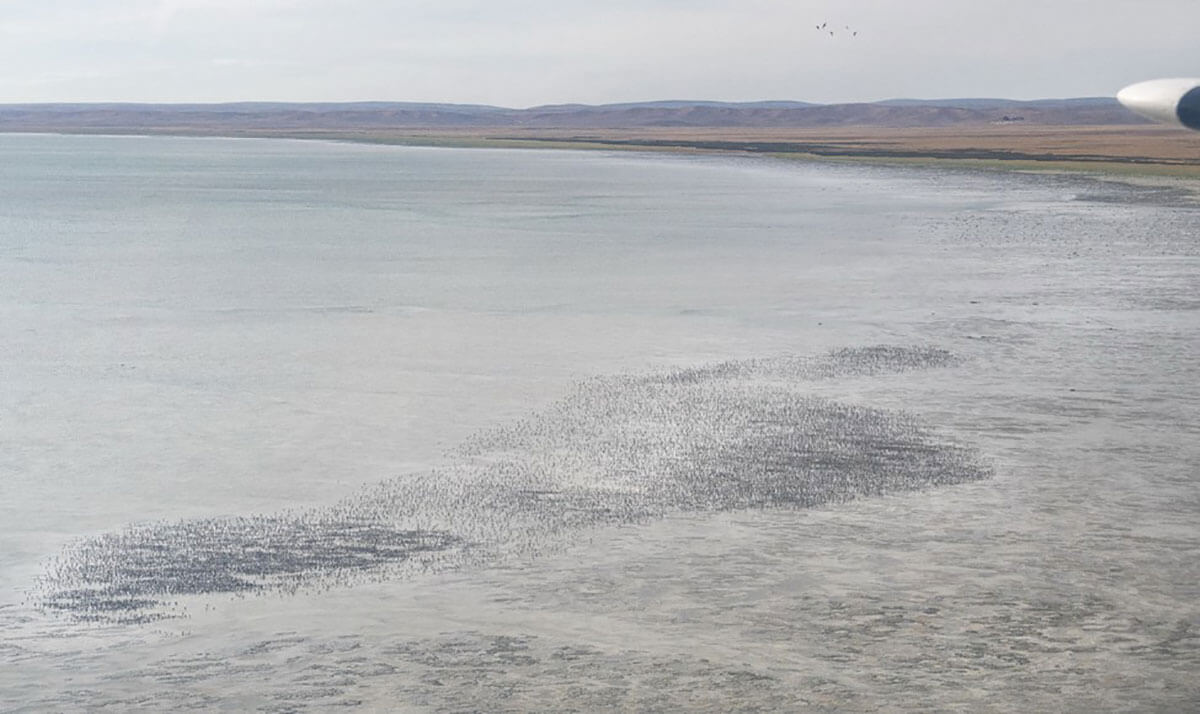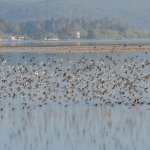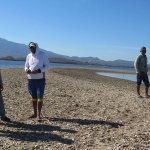In January 2019, aerial surveys were successfully conducted of the population of rufa Red Knot Calidris canutus wintering in Tierra del Fuego, South America. This year’s surveys revealed a total of 13,190 birds. This is a welcome return to the more typical numbers from recent years, after the lowest-ever count of 9,840 birds in January 2018. As recently as 2000, the population numbered over 50,000 birds, but during the following decade it crashed to around 10,000 birds by January 2011. Since then, the annual survey total has varied between about 10,000 and 14,000.
Reasons for the increase from 2018 are not clear but may be related to breeding success over the past two years. Adult Red Knot departed Delaware Bay on spring migration in relatively poor condition in 2017 (L. Niles pers. comm. to G. Morrison), which was thought to lead to the lower total in January 2018 in Bahía Lomas, but reasonable numbers of juveniles were observed on southward migration in James Bay (C. Friis pers. comm. to G. Morrison) and in the Mingan Archipelago (Y. Aubry pers. comm. to G. Morrison) in Canada during the southward migration. In 2018, Red Knot left Delaware Bay in good condition, but late snow melt on the Arctic breeding grounds caused a challenging nesting season. Nonetheless, many were apparently able to subsequently attempt breeding with moderate success (as evidenced by good numbers of juveniles in James Bay, and moderate numbers at Mingan). The increase in numbers in Bahía Lomas in January 2019 may thus reflect the moderate reproductive success of Red Knot in 2017 and 2018, combined with good adult survival over the past year.
In recent years nearly all of the Red Knot counted during the annual aerial survey have been found in Bahía Lomas, Chile, a WHSRN Site of Hemispheric Importance. And 2019 was no different. In fact, the only Red Knot recorded during the aerial survey were in two flocks in Bahía Lomas totaling 13,100 birds. No Red Knot were recorded in Bahía San Sebastián or at Río Grande (both in Argentina, together another WHSRN Site of Hemispheric Importance), though up to 90 birds were recorded at the latter location during ground surveys. This was once the other major wintering area in Tierra del Fuego, with counts in the range of 3500 to 5000 birds as recently as 2008, but numbers have fallen drastically since then.

A large flock of knots and godwits in the western portion of Bahia Lomas, 20 January 2019. Photo: Antonio Larrea.
The concentration of nearly all the Red Knot in one location (Bahía Lomas) makes them particularly vulnerable to any environmental problems that might occur locally. Fortunately, in January 2019 Bahía Lomas was declared a Nature Sanctuary by the Chilean government. However, in the words of WHSRN Conservation Specialist Diego Luna Quevedo, “the challenge now is to articulate a good governance process for the management of the area and the effective protection of its conservation targets, through the participation of and collaboration between key stakeholders.”
Bahía Lomas and Bahía San Sebastián (Argentina) are also both major wintering areas for Hudsonian Godwit Limosa haemastica. The 33,530 godwits counted between both Bahía San Sebastián (14,450) and Bahía Lomas (19,000) were similar in total to the 35,550 observed in 2018. Totals of godwits have varied between about 24,000 and 40,000 between 2011 and 2018. These totals are lower than those in the early 2000s, suggesting a steady decrease since 2002.
The annual aerial survey in Tierra del Fuego is a key metric for assessing the recovery and success of conservation efforts for the Red Knot, and for tracking the health of other shorebird populations such as Hudsonian Godwit. The 2019 surveys were conducted by Guy Morrison and Antonio Larrea with the support of the Aeroclub Cerro Sombrero (Chile) and Santiago de Larminat (Aeroclub Río Grande, Argentina). The surveys were made possible thanks to generous support from anonymous donors to Manomet, Inc. and Guy Morrison, and the many donors who contributed through a GoFundMe campaign. Dr. Larry Niles also helped provide funding for the work. Carmen Espoz (Santo Tomas University, Santiago) facilitated arrangements for the surveys in Chile. Maria Luisa Carranza and Soraya Acardi (Áreas Protegidas y Biodiversidad, Secretario de Desarrollo Sustenable y Ambiente, Provincia de Tierra del Fuego, Antartida e Islas del Atlántico Sur) assisted with the very efficient issue of a permit in Argentina, and Tabaré Barreto was most helpful in assisting with arrangements for the work in Río Grande.
For more information, please contact Guy Morrison (rigmorrison@gmail.com)
Cover Photo: Antonio Larrea.






